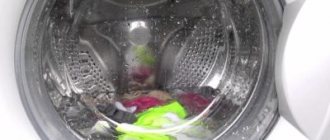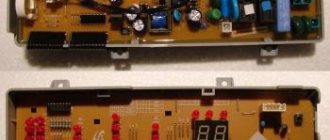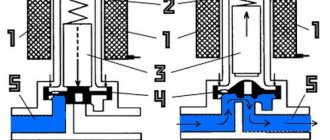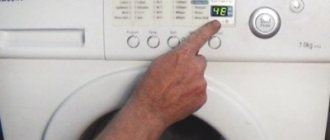The equipment of the Italian company Zanussi is reliable and easy to use, but even it can fail. No one is immune from breakdowns or manufacturing defects. Household appliances can also break down due to improper handling or makeshift repairs done without preparation. If, for example, a Zanussi washing machine does not drain water, then some users immediately begin to disassemble and clean it.
If you are not confident in your abilities, contact the service center. Or read our article. It will help you pinpoint the cause of the breakdown and develop a clear plan for repairing your washing machine yourself. Remember that first you always need to disconnect the equipment from the network, and only then begin diagnostics.
Diagnostics
Before starting repairs, you should check exactly how the drain or spin cycle is broken. This information will help you localize the location of the breakdown, which will allow you to repair your washing machine quickly and efficiently.
- Draining of liquid from the reservoir occurs extremely slowly.
- The next washing step does not start correctly.
- Water remains in the drum. The wash stops.
- After the end of the working cycle, a small amount of water remains at the bottom.
- No water is drained during the spin or rinse phase. It begins to decrease only at the end of the working cycle.
Malfunctions in the operation of the Zanussi washing machine can also occur due to the fault of the user. Make sure that the selected operating mode matches the type of laundry you are loading. Try changing the mode. This may be enough to start draining the water.
Never load the machine with more than the design allows. Not only will this disrupt operation, but it could also lead to more serious damage in the future.
Preparation for repair
A faulty water drainage system prevents the wash from completing. A washing machine filled with water simply stops working. The first thing to do in this case is to try to reboot it. To do this, unplug the machine, wait a few minutes, and plug it into a power outlet. These steps can help fix a minor software glitch.
If this does not help, then before starting the repair, do the following:
- unplug the power cord;
- remove all water from the drum.
You can scoop out all the liquid from the washing machine using a regular ladle, but this method is not very effective. If the blockage occurs in the sewer, then you can drain the water through the drain hose, having first disconnected it from the sewer pipe.
There is also an emergency hose located at the bottom of the housing. It is hidden behind a removable panel. Users who have experience in repairing such equipment can independently disassemble the washing machine and drain the water by removing the drain pipe and filter.
Zanussi washing machine does not drain water
Is your washing machine not draining water? This is one of the most common faults and has various causes.
Symptoms:
- The water drains, but very slowly, followed by a failure in the program.
- The washing program stops at the draining stage and the water is not drained.
- The water drains, but not with every wash.
- The water is drained only during the washing phase; it is not drained during rinsing.
- Locking the spin mode after draining the water from the tank.
Causes:
- Pump filter clogged
- The pipe connecting the tank to the pump is clogged.
- A foreign object has gotten inside the pump, the impeller is jammed.
- Pump fault.
- The drain hose is clogged.
- The siphon or sewer pipe is clogged.
Repair steps: Zanussi washing machine does not drain water
De-energize
Unplug the power plug from the socket.
Pump filter
Before unscrewing the filter (located below the loading hatch), you need to place a low container to drain the water. If the filter is clogged, you need to clean it and install it back.
Cleaning the drain pipe
If the filter is removed and the remaining water from the tank is not drained, then the pipe leading from the tank to the pump is clogged. You can get to it by unscrewing the screws securing the drain assembly (snail). After disconnecting the drain assembly from the body, you need to loosen and remove the clamp securing the pipe to the volute, and direct the freed end of the corrugated pipe into the prepared container for draining the water. Carefully probe the corrugation for the presence of large foreign inclusions, and clean if necessary. Put on the clamp and assemble the entire drain assembly in reverse order.
Impeller jamming
If the water does not drain even though the pump pipe and filter are working properly, you need to check the rotation of the pump impeller. It is located immediately behind the filter. The presence of even a small foreign object (button, hairpin, etc.) can cause the impeller to jam. If you find a foreign object, remove it.
Checking the pump's health
The pump is checked last, since it is the last link in the water drain chain. To do this, with the filter removed, turn on the “Spin” mode and shine a flashlight into the hole for the filter. If the impeller is not clogged but does not rotate, then the pump is faulty and must be replaced. To do this, disconnect the drain assembly (volute) from the body of the washing machine, disconnect the pump from the volute and the wires going to the pump. All manufacturers use standard pump designs; they are sold separately.
If the water does not drain, all the previous points have been checked, everything is fine and the impeller rotates with the filter removed, then there can be two reasons: loss of pump power, which is only enough to rotate the impeller idle, or a clogged drain hose or sewer pipe. The pump needs to be replaced, the hoses and pipe cleaned.
Check after repair
Carefully inspect all affected connections, tightness of clamps, fastening screws, and wire fastenings. Turn on the washing machine and check its operation in all modes. Disconnect and once again check all connections for leaks and tightness. If necessary, recheck the problem area until the problem is completely eliminated.
Moscow st. Presnensky Val, 38, building 6
+7 (multichannel)
Blockage
An error in the operation of equipment can occur at any stage of operation. The most common reason why a Zanussi washing machine does not drain water or spin clothes is a blockage.
It can occur in such elements of the water drainage system as:
- drain hose;
- filter;
- pump impeller;
- drain pipe.
Breakdowns of this type can be easily repaired at home. The cleaning method depends on the nature of the problem. In some cases it is necessary to use specialized equipment.
ZANUSSI washing machine does not drain water
| Home » ZANUSSI |
Is your ZANUSSI washing machine not draining water?
Why and what to do? Contact our company. We will find the reason! We will repair your washing machine at home and fix the problem. We work seven days a week in Moscow and the Moscow region. Free visit of a technician to your home + diagnostics (for repairs)
The most common failure in washing machines is when the drain does not work. This applies to all brands of washing machines, and ZANUSSI washing machines are no exception.
The most common reasons why there is no drain:
- » entry of foreign objects;
- » incorrect connection of the drain pump;
- » breakdown of the pump motor.
If the machine does not drain well, first read the operating instructions for the washing machine. After this, if the breakdown is not described in the application, you should contact a qualified technician, and he will find out why the ZANUSSI washing machine does not drain water or some other washing machine, for example, the ZANUSSI washing machine does not drain. A breakdown of this nature stops the operation of the entire mechanism.
Repairs and troubleshooting can be done at home. Calling a technician to your home will reduce the time spent searching for service centers. The technician will answer your question, what is the reason for the poor drainage or its absence.
Prevention of breakdowns associated with poor drainage of water in washing machines
First of all, you need to very carefully check the pockets before loading the wash, choose the right washing mode, clean the filter (preferably after each wash), check the drain (very often it can simply be turned off), and prevent products that have the property of getting into the washing machine. foam a lot. The most real housewives strive to make their equipment look good, but a beautiful appearance is not yet an indicator of its serviceability. A washing machine, like a number of other appliances, needs timely prevention and diagnostics. Then your washing machine will serve for many years and will delight you with its excellent, impeccable work.
Cleaning the drain filter and pipe
The filter is located at the bottom of the washing machine. It is hidden behind a removable panel made of the same material as the body. If you cannot find it and open it yourself, use the instructions. She will tell you what to do. Behind the panel there is an emergency hose and a pump filter. Please note that the filter is sealed with a rubber gasket.
In order to remove it, you need to apply some force. However, don't overdo it; some blockages may also prevent it from being removed. Once you have the filter in your hands, you can clean it by hand or with a brush.
The drain pipe is located in the machine body itself. It is highly not recommended to dismantle it yourself. Call specialists to your home. If you are confident in your abilities, then using the instructions, you can disassemble the washing machine and clean this part yourself.
The washing machine does not drain water: ways to solve the problem
One of the most common problems with washing machines is the water not draining. The problem can arise for various reasons. But before finding out the source of the problem, you need to understand how exactly the problem is defined. This article discusses ways to solve the problem and provides recommendations for prevention so that the water always drains naturally at all stages of washing.
Reasons why the washing machine does not drain water well
The types of malfunctions are as follows:
- The water drains extremely slowly, and the process is accompanied by errors on the washing machine display.
- During spinning, draining or another stage of washing, water does not flow out naturally, and errors also appear on the display.
- Some washes drain the water, others don't.
- There are no errors during the main wash, but during the rinse phase the washing machine does not drain the water.
- After draining, the spin cycle is blocked.
After identifying the problem, it is easier to understand in which element of the washing machine the problem should be looked for.
Filter clogged
The filter in the washing machine is necessary for the normal operation of the drain pump; it is located in front of it. It traps lint and threads from clothes, as well as small objects that can damage the drain pump if they get inside. The filter may become so clogged that it will not allow water to pass through. Therefore, it needs to be cleaned from time to time. To do this, just unscrew the cell from the bottom of the washing machine and rinse the elements under running water, after removing all the debris.
Problems with the pipe
If the blockage has passed further into the pipe, you will have to open the washing machine body. To do this, you can call a specialist, or do the following steps yourself:
- cut off the water supply;
- remove the hoses attached to the back of the washing machine;
- cover the floor with a rag;
- remove the powder container;
- Using the exhaust hose from the service hatch at the bottom of the machine, drain the remaining water into a low basin;
- remove the filter.
After removing the filter, you need to remove the pipe using a screwdriver or pliers, clean it and dry it. Before installation, it is best to lubricate the fitting area with sealant.
Impeller problems
One of the most frequently broken parts of a washing machine is the pump impeller (drain pump). Small debris such as coins and buttons can cause the impeller to fly off its axle and stop functioning. As a result, the pump also malfunctions and does not pump out water. The impeller can also fly off during the draining mode, at the first revolutions. The reason is unreliable fastening. The problem is solved quite simply, but requires soldering skills. Having made a hole in the impeller, you can fasten a cut bolt with a diameter of about 3 mm in it. With a reliable fastening, the impeller will not fly off, ensuring normal operation of the pump.
Pump fault
The washing machine stopped draining water due to pump failure. But before you start disassembling the washing machine, you need to determine the cause in more detail. To do this, monitor the operation of the pump. For prevention, it is also necessary to clean the filter and check the drain hose. After this, you can inspect the sensors and contacts going to the pump panel. With the proper skills and experience, the malfunction will be noticeable at the stage of draining or filling in water - the pump will begin to hum and try to intensively pump out or pump in liquid. In this case, water does not enter the tank. Errors will most likely appear on the display.
Electrical wiring fault
If the drain in the washing machine does not work and the indicators do not light up when turned on, it means that there is a problem with the electrical wiring. The first step is to check the voltage at the outlet. To do this, use a two-pole indicator or multimeter. If there is no voltage, you should disassemble the socket and see if the wires are intact.
If the socket is working properly, then the reason may lie in the damaged cord of the washing machine. To fully check the integrity, it is necessary to disassemble the housing and determine where the wire goes. If there is no voltage at the end of the cord, it should be replaced.
If the cable and socket are working properly, you need to look for a breakdown in the control unit of the washing machine. To do this, you need to find the place on the board where voltage is supplied and test it with a multimeter. If it is equal to the network voltage, it means the board is damaged. It needs to be replaced.
Pressostat malfunction
The pressure switch is a round part with a plastic body. The hose and wiring are connected to it through the valve. Using a pressure switch, the module receives a signal to stop water intake. It is located at the top of the washing machine body, usually near the side wall. A malfunction of the pressure switch is most often indicated by an error code that appears on the display after self-diagnosis during washing. To decipher the code, you need to look at its meaning in the instructions. If the pressure switch breaks down, the water will not drain well or not come out at all. Repairing a part requires special skills or the help of a technician.
Programmer malfunction
The programmer is easy to identify on each washing machine - it is a control element that is a knob on the main panel. It looks simple, but in reality it is a complex mechanism that controls the inclusion and deactivation of all stages of washing, as well as the supply and drainage of water. If you disassemble the case, you can see that the programmer consists of many small parts, any of which can be broken if the water is not drained properly.
A programmer failure is characterized by a sudden shutdown of the washing machine. Often, if this part malfunctions, the machine does not turn on at all. The washing time indicated on the display is also missing or constantly changes when the programmer fails.
How to drain the water
In order to drain water from the washing machine, even if it is broken, you must:
- turn off the power;
- open the filter cover from the bottom of the housing;
- pull out the emergency drain hose;
- direct the end of the hose into a low and wide container to drain water;
- remove the safety plug and wait until all the liquid flows into the basin.
A deep container is needed so that the water level at the end of the hose is lower than in the washing machine body. The deeper the basin, the more water can be drained from the housing.
DIY repair
Ariston
Sometimes Ariston brand washing machines require special attention. Often, repairs can be done with your own hands, without the help of a specialist. The most common error that occurs during normal washing is indicated on the display by code F05. Before the indication, the machine does not drain the water and hums or crackles, as if an object has gotten inside that is impeding the operation of the fan. When you try to continue washing, it will still give an error until it is corrected.
The reason may lie in a control failure. Electronics often malfunction and display an error message randomly. Try restarting the washing machine by holding down the power button or unplugging the power plug. If the error code does not disappear, it means the filter is clogged. Debris caught in it prevents the normal drainage of water. To clean, you need to remove the cover from the bottom of the machine body, remove the filter and rinse it under water, removing wool, lint and other dirt.
Atlant
If error F4 occurs when washing clothes in an Atlant brand automatic machine, it means that the program does not reach the spinning stage. Because of this, the water does not drain, or it drains too slowly. You can fix the error yourself in several ways, one of which is cleaning the drain filter. Villi, threads and other small debris from clothes get inside it. To remove the blockage, you need to remove the filter and clean it under running water.
It also does not drain water due to a kink in the drain hose. To fix the problem, you need to inspect it from the body of the machine to the sewer and release the clamp if necessary. Another reason for poor water drainage is a sewer blockage. To check, start the wash by first disconnecting the hose from the drain and placing the end in the sink or toilet. If at the end of the wash the drainage is normal, you need to clean the drain.
Zanussi
Most often, when the water drains poorly, Zanussi washing machines display error codes E11, E12, E21 and E22. When they appear on the display, the first thing you need to do is clean the drain filter. It is located inside the bottom of the washing machine. Contaminants accumulate in it not only due to bad water, but also due to clothes being washed. There are too many threads, spools and other debris on it. After removal, the filter must be disassembled and washed under the tap. Often coins, hairpins and crumpled pieces of paper get inside.
Like other brands, poor water drainage in Beko washing machines is most often due to a clogged drain filter. The main task remains the same - you need to find it and clean it. The filter is located at the bottom of the housing under a small hatch or behind a panel. Before removing, you should substitute a basin, as the remaining water will flow out of the emergency compartment. After removing the filter, rinse it by hand under the tap. At the same time, clean the pipe located next to the filter. Sand and rust accumulating in it interfere with the normal flow of water into the drum.
If the problem is not resolved after cleaning the filter, check the drain pump. Most often, on Beko washing machines, pump failure is signaled by code H5. To check, start the spin mode and listen to how the pump and impeller behave. If rotation is difficult, clean or replace the pump.
If the water in the Ardo washing machine does not drain during the spin cycle, the drum will begin to spin constantly without gaining significant speed. The pump may work normally, but water will drain from it. First of all, you need to clean and rinse the filter, blow out the drain hose and drain the water yourself. If the problem is not solved, check the contacts of the pressure switch. They can stick, sending a false full tank signal to the control module. To eliminate the malfunction, blow out the pressure switch hose.
Another common reason why water in Ardo machines does not drain is a stretched belt responsible for rotating the drum. It should be noticed that it is 5 mm smaller than the original one, then the engine will gain the required speed.
How to prevent filter clogs
For normal drainage of water, prevention is necessary, the purpose of which is to prevent blockages inside the washing machine. Before each wash:
- check your clothing pockets for coins, receipts and other debris;
- use covers and bags for washing clothes, sold at any hardware store;
- fasten clothes with zippers and buttons.
It is also advisable to clean the internal filters of the washing machine 2 times a month.
Inspection of the pump (pump)
The failure of this part can only be determined by the residual principle. Except in cases where it was preceded by the following events:
- extraneous sounds during draining and spinning;
- repeated minor malfunctions in the operation of the Zanussi washing machine.
Although you can replace the drain pump yourself, this should only be done when the warranty period has long expired. Otherwise, contact the service center. Repairing this type of fault takes a short amount of time.
Hardware failures
Failure of the electronic elements of a washing machine is always associated with large expenses. No one will repair these devices. Craftsmen prefer to simply replace broken components. A faulty control unit can be recognized by the absence of signals on the front panel or by system error codes.
This type of breakdown also includes malfunctions of the water level sensor in the drum. Its malfunction leads to disruption of the drain and spin cycles due to the fact that it is directly connected to the pump. This part cannot be repaired. It can only be replaced at official Zanussi service centers.
The washing machine does not drain water
Some of the reasons that cause a malfunction such as a washing machine refusing to drain water can be eliminated (or at least diagnosed) yourself.
Common problems and their solutions
- Often, when choosing a gentle wash program, we forget that the machine does not spin, which can deform things. Consequently, a water stop occurs. As noted in the diagram (see above), it is enough to progressively give the commands: START - STOP - CANCEL, and the problem will be eliminated.
- The drain hose is the next reason why water may remain in the car. Often, for one reason or another, it becomes deformed (bent, “crumpled” or pinched). Naturally, the water simply cannot drain due to these mechanical damages. Eliminate the cause and the machine will work properly again.
- If the drain hose is connected to a siphon, then you need to check how good both of them are (that is, whether there are any blockages in both). Separate them, lower the hose, for example, into the bathtub (or place a bucket or basin) and give the machine any command. When this malfunction occurs, water should begin to flow out.
If it is determined that the hose is working properly, then inspect the siphon for clogging. If this is the reason, then you can clean it using any special liquid or disassemble, wash and reassemble.
For deeper clogs, you can use a plumbing rope.
- A clogged machine filter is a more complicated matter. You can try to take it out and wash it yourself. Use a plumbing detergent for this, and also inspect for the presence of foreign objects (for example, clothing threads) and reinstall.
Note that this procedure does not always help: the pipe may become clogged, and this requires opening the housing. Naturally, it is better if a master does this. 5. If a pump (pump) in a car breaks down, it can also lead to similar problems. Most likely it will have to be replaced. But only a professional can determine the reason here. 6. In the event of a malfunction, control modules can also result in the “reluctance” of the washing machine to drain waste water. This is due to the fact that the corresponding signal is not supplied to the pump motor. (If the car is electronic). In mechanical ones, this role is performed by the programmer. This needs professional repairs. 7. If the water level sensor (pressostat) malfunctions, the machine simply “does not understand” that some amount of liquid inside has not yet been drained, and therefore it remains.
So, if you notice a problem with draining water, you can try to fix the problem yourself. Do not forget about safety precautions, since neglect can become a source of increased risk . If you are not confident in your own abilities and qualifications, call us. We will make repairs quickly and efficiently, and we will issue a documented long-term guarantee for all work performed. When ordering online, we will provide a discount, as well as provide detailed advice on all issues related to the further operation of your equipment.
Other faults
Failures of this type are less common. They are usually associated with the secondary systems of the washing machine. This type of breakdown includes:
- drum bearing failure;
- malfunctions in the cleaning agent supply system;
- scale on the heating element;
- door lock.
It is extremely easy to determine whether a bearing is faulty. Spin the drum by hand. It will move with great difficulty, making grinding sounds. Bearings can be easily replaced at home, if disassembling such a device is not difficult for you.
A jammed door can be opened in several ways:
- Manually. Just use a thin metal ruler or spatula.
- Programmatically . Turn on the “rinse” mode. At the end of the cycle the door should open.
- Reboot . Unplug your device, then plug it back in after a few minutes.
Prevention of breakdowns
You can extend the life of your Zanussi washing machine by following a few simple recommendations from experts. Wash clothes in small batches. Heavy weight leads to rapid wear of bearings.
Use products that prevent the formation of scale on the heating element. If the voltage in your electrical network fluctuates, use stabilizers. This will help protect electronics from damage. And most importantly, clean the filter several times a year. By following these recommendations, you can avoid situations where the washing machine stops draining water during the spin cycle.
Most common reasons
Where to start looking for the reason why the Zanussi washing machine refuses to drain water and spin clothes? You need to start with the simplest and most obvious, which does not require disassembling the washing machine, and then, gradually, move on to more complex and rare causes. Let's start with the garbage filter. We unscrew it and check for dirt and foreign objects. This should be done even if you clean the filter regularly, since socks and other small items often get caught there during washing.










